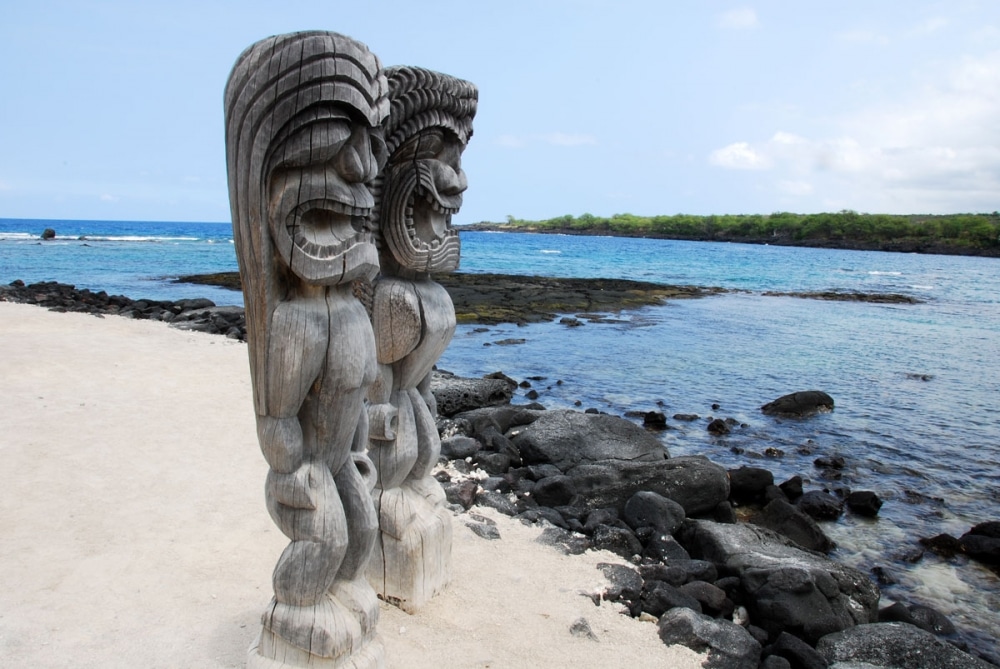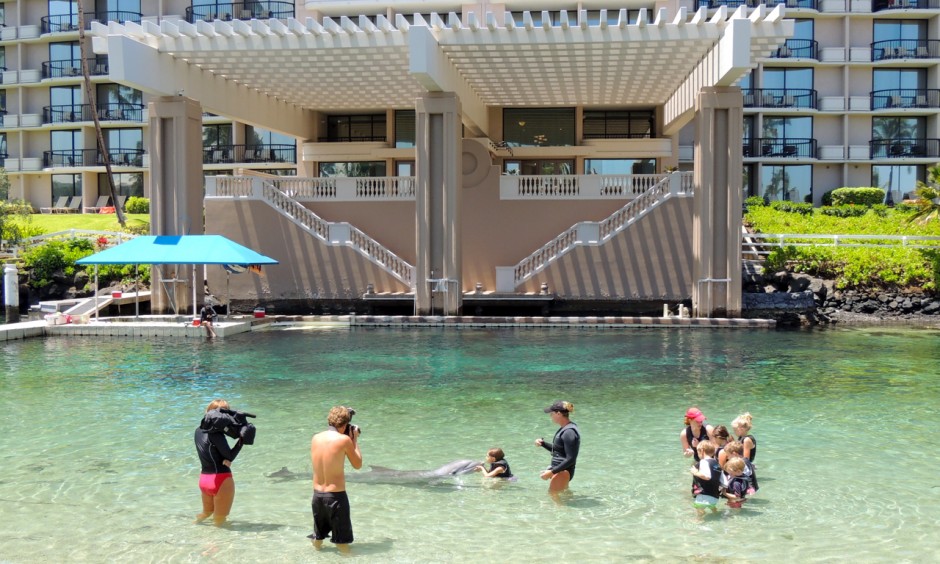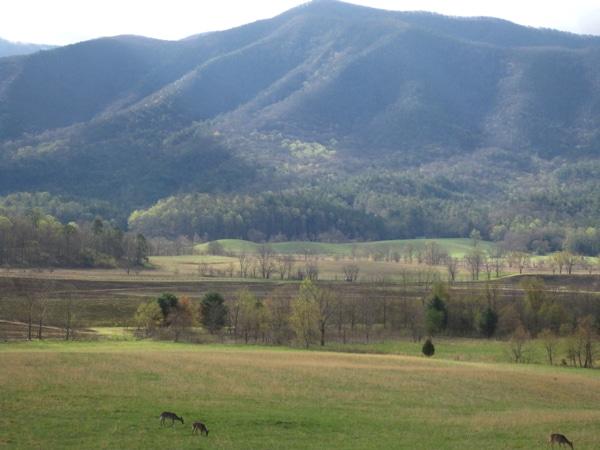Our last stops in Washington were Yakima and Spokane. Yakima is a town of about 80,000 people, nearly 40 percent of whom are Hispanic. One reason for this is that the region is heavily oriented toward the production of agricultural products, especially apples, cherries, grapes, asparagus, and hops. It has been called the “fruit bowl” of the nation. Wherever there is large-scale farming, there will be Hispanic farm workers, usually poorly paid. The median household income in Yakima is more than 20 percent lower than the national average. The incidence of poverty is correspondingly a good deal higher than the national average.
We drove into Yakima from the North, taking I-82 from the main east-west highway, I-90. This is a great drive, rising high above a beautiful farming valley. Fruit trees grow on hillside terraces with rows of barrier trees protecting them from wind and with netting on top to prevent birds from eating the fruit. Where there is not irrigated farming the land is dry and desert-like. When you reach the top of the hill, a wondrous sight awaits you – a magnificent view of both Mt. Adams and Mt. Rainier, the latter the central wonder of Mt. Rainier National Park.
The main thoroughfare of Yakima is North First Street, and this is where the motels are. We checked out a few of them, disappointed that the one we wanted wouldn’t honor our discount coupon. Motels sometimes place coupons in the discount books just to get customers in the door. Then they say that the discount rooms are all taken or are only available when the occupancy rate is below a certain level and unfortunately this is not the case today. We settled on a Travelodge, cheap, although a little worn and shabby. It amazed us that there were so may motels here; Yakima is hardly on the “main line.” And some motels demanded a rather high room price considering their location next to a smelly industrial plant and right along the railroad tracks (we saw huge pallets of neatly stacked wooden fruit crates beside the tracks. Later that day the proprietor of the bookstore told us that these were being replaced with plastic crates, eliminating some local jobs.) As with many towns, Yakima’s downtown had been allowed to deteriorate, and today efforts are being made to restore it. There are a couple of good motels in the heart of downtown, and there were people on the streets in the evening, good signs for the future.
The bookstore I spoke at is called Inklings. It is a handsome store with plenty of comfortable chairs for customers to sit on while they browse books. One of the staffpersons, Susan, made us feel at home. She had read my book and was enthusiastic about it. A math teacher at the local community college and a small group of women who were member of a book club comprised my audience. It was a good evening. I tried out a couple of new ideas. One that seemed to be well-received was the notion that the runaway inequality in our society is detrimental to democracy. People grasp this right away. We spoke with Susan for awhile after the reading (she told us to be sure to get some local cherries before we left), bought two Illume candles (our favorite), and went back to our motel. I was pleased to think that I am almost surely the only Monthly Review author to speak in Yakima, and my book is the only MR book ever to be in the Inklings book store. Next morning we backtracked to I-90 and headed for Spokane, the biggest city in the “inland northwest.” We were delighted to be in a hotter, drier climate and into more wide open spaces.
Spokane is about 200 miles from Yakima, most of it along I-90, which straddles miles of irrigated farms, growing wheat, peas, corn, alfalfa, and seed. Some of the land is marked by deep indentations or coulees; the Grand Coulee Dam sits north of the highway, about eighty-five west of Spokane. This dam is one of the largest concrete structures in the world and was built during the dam-building frenzy of FDR’s four terms in office. Grand Coulee, one of twelve along the Columbia River, in both the United States and Canada, slows down considerably the “roll” of the mighty river. A good book on water and dams in the west is Cadillac Desert by Marc Reisner. Grand Coulee is a major source of electric power in the northwest, and it allows for the irrigation of half a million acres of farmland in the dry desert surrounding it. Usually missing from discussion of dams is their impact on American Indians. Here is what a Washington Post reporter said in 1993:
The modest sign poses a question whose answer may come to rattle the most profitable pillar of the federal government’s public-works empire in the West.
Looking just upstream from the steel bridge, the question becomes obvious. For there is the greasy-grey concrete monstrousness of Grand Coulee Dam. It is the largest producer of electricity in the United States, a half-century-old totem of American engineering virtuosity, and the economic cornerstone for nine million people in the Pacific Northwest.
“The mightiest thing ever built by a man,” sang Woody Guthrie, the folk balladeer whom the federal government hired in 1941 to write pro-dam propaganda. Guthrie churned out 26 songs, most of them glorifying a concrete behemoth that bottled up what he called the “wild and wasted” Columbia.
Praising Grand Coulee Dam was-and remains-easy work. Its hydroelectricity built ships, airplanes, and atomic bombs that helped win World War 11. The dam seeded the Northwest with aluminum factories and fueled the emergence of the world’s largest airplane-maker, Boeing. It diverted water to create the most elegantly engineered irrigation project in North America. The dam is still the backbone of a regional power-grid that provides the cheapest electricity in the country. Without Grand Coulee Dam it is almost inconceivable that Washington, Oregon, Idaho, Montana and the Canadian province of British Columbia could have been transformed in less than fifty years from a boondock into a booming, high-tech region whose gross national product makes it the 10th largest economy in the world.
Yet the little sign on the steel bridge casts a curious shadow. If the Colville Reservation extends half-way across the Columbia, shouldn’t its members have a claim to power from Grand Coulee Dam? Aren’t the Colville Tribes due a slice of the $412 million worth of electricity that the dam generated last year? Don’t they have, a right to some of the tens of billions of dollars worth of power that the dam has produced in the past five decades?
If the answer to these ownership questions were yes, even a qualified yes, then the Colville Reservation would be home to 7,775 exceedingly well-heeled Indians. For the past half century, however, the federal government’s answer has been a resounding no, and the Native Americans who live on the far side of the steel bridge are about as far from well-heeled as is possible in the prosperous Northwest.
“I attend death scenes on the reservation,” says Allen Nielson, the white prosecutor and coroner for Ferry County, which includes part of the Colville Reservation. “Typically, what I see is a young Indian male with high blood alcohol and perhaps some drugs. He has been suffering from depression and unemployed for some period of time. It is usually a gun shot or a traffic accident. You can take a graduating class at Inchelium High [on the reservation] and in ten years they are all dead. It is absolutely staggering.”
It is only now, in the summer of 1993, that the question raised by the little sign on the bridge is being taken seriously by the U.S. government. The U.S Court of Appeals for the Federal Circuit ruled last year that the government has failed to make “fair and honorable dealings” with the Colvilles as regards compensation for power generated on reservation land. It ordered a new trial on the tribes’ claim for a percentage of the dam’s earnings.
Instead of locking horns in a protracted and expensive trial, both the Colvilles and the Justice Department have opted, at least for the moment, for a negotiated settlement. . . .
Before Grand Coulee Dam was completed in 1941, the Confederated Tribes of the Colville Reservation centered their lives around Columbia River salmon. The Colvilles were one of the last Indian groups in the United States whose lives, as of the 1930s, had not been fundamentally changed by whites.
An anthropologist estimated that before the dam was built each tribal member ate one and a quarter pounds of salmon a day. The most sacred ceremonies of Indian life, along with the most intensive season of work, feasting and recreation, revolved around the summer migration of salmon. The biggest and choicest of the salmon were the summer Chinooks.
Whites called them “June Hogs” because they often weighed 60 to 80 pounds. Most of these big salmon were caught in traps in the white-water at Kettle Falls on the Columbia.
Nearly a mile wide, 550-feet high and built with no fish ladders, Grand Coulee Dam blocked all upstream passage of salmon. About 1,400 miles of spawning grounds were lost. Kettle Falls disappeared under Franklin Roosevelt Lake. The dam that the U.S. government paid Woody Guthrie $3,200 to lionize in blue-collar ballads wiped out more salmon than any single structure in American history.
Without salmon, the Colville Tribes fell apart. Rates of suicide, fatal car accidents, alcoholism, drug-addiction, divorce and death by house fire on the reservation soared to levels that stunned a white anthropologist who had studied the Colvilles before the dam. Verne Ray, who lived among the Indians when the salmon were still running, said Grand Coulee Dam “involved a ruthless disregard for Indians as human beings. The result can only be called a disaster for the Colville people.”
The dam pumps water to more than half a million acres in the Columbia Basin Irrigation Project, The entire project lies across the river from the reservation and Indians receive none of the water.The U.S Bureau of Reclamation has given 4,000 landowners in the project (almost all of whom are white) an infrastructure subsidy of $2.1 million per 960-acre farm. In addition, water for these farms is “virtually free,” according to Jim Cole, who manages the project for the Bureau. Farmers pay just $25 per acre a year for water that, if it were puddled together on a concrete. floor, would stand four-feet deep.
As the non-Indian side of the Columbia blossomed, the reservation withered. Drinking water and phone service to some parts of the reservation were cut for 30 years. The dam flooded more than 21,000 acres of prime bottom land, where the bulk of the Indian population had lived for centuries. The best hunting, farming and root-gathering land disappeared. Although they live in the shadow of the big dam, reservation residents pay more than twice as much for electricity as do their neighbors across the Columbia in Grant County. While the Columbia Basin continues to attract new industries (drawn by cheap power and water), unemployment on the reservation has hovered around 50 percent for decades. A chart of income distribution on the reservation shows there is no middle class.The dismal contrast between Indian penury and white success is on display here in Coulee Dam. A highway winds down into the town from parched reservation land that is littered with wrecked cars and abandoned washing machines. At the city limits of Coulee Dam, which was built by the Bureau of Reclamation and is occupied mostly by white dam workers, rusted junk and blowing dust give way to freshly painted houses, tidy green lawns and the steady stitching of sprinklers.
As part of air after-the-fact environmental impact statement that the Bureau of Reclamation prepared on Grand Coulee Dam in 1975 (42 years after work began on the project), Colville leaders were asked what the dam [lad done for them. In a statement of sorrow and acid resentment, they said “tribal members paid with their homes, their lifestyle, their foodstuffs, so that others could have jobs, incomes, and wealth – The Indians are treated as non-persons.”
0ut on the Colville Reservation and upstream from Grand Coulee Dam, there is another small and easily missed sign. It lies in the dirt on a hillside just above a ferry landing.
“DRUGS, ALCOHOL, SUICIDE,” the sign says, and it has a drawing of an Indian brave slumped over a horse. The hand-painted sign is on a ranch owned by Martin Louie Sr., an 86-year-old Colville Indian.
Louie is a story-teller, an “informant” for latter-day anthropologists, a sobered up alcoholic and one of the last remaining Colvilles who speared Chinook salmon in the Columbia before the dam. He lives in a leaky camping trailer covered with a blue plastic tarp to keep out the rain.
The trailer has a view of what Grand Coulee Dam did to the upper Columbia Basin, mutating a wild river into a placid lake.
“You asking me what did we do after the flood? We, starved. We drank. My daughter-in-law’s son committed suicide. He blowed his brains out about three or four years ago with a rifle. I know two or three who committed suicide,” Louie said.
The old mail who has rheumy blue eyes (the legacy of a Welch grandfather who worked for the Hudson’s Bay Company) said the salmon he eats now comes in cans that are part of a federal program for elderly Indians.
Fetching a can of food-aid “PINK SALMON” from a shelf, Louie thrust it in a white visitor’s face.
“You guys took all my food,” the old man said. “This is how you replaced our salmon.”
©1993 Blaine Harden
We got to Spokane in early afternoon and checked into a Howard Johnson motel. Here the clerk took our coupon but tried to get us to upgrade to a more expensive room. We demurred; we were only staying one day, so even a dingy room would probably be alright. Ours was, the ripped drapery notwithstanding. We took a walk around downtown Spokane, a larger and more prosperous city than Yakima, although it has a considerably lower than average household income. Unlike Yakima, it is overwhelmingly white. The most impressive things about Spokane are the park and walkways along the Spokane River. The river’s water drops over a series of rocky falls; the walkways and a tram provide exciting views. The bookstore, Aunties, is on Main Avenue; it takes up three floors in an old furniture store. Again, the staffperson, Linda, in charge of my event was great; she ended up buying three copies of the book to give as gifts. I spoke in the café connected to the store. After I returned to the store to sign books.
During the discussion, Linda asked me about getting my book out to the general public. Weren’t most of us preaching to the choir; not many people were interested in grappling with ideas different from their own. I said that there was truth to this, but that one reason books like mine find it hard to reach a mass audience is because it is difficult to get such books publicized. Promotion is critical, especially on television, but this usually too expensive to obtain. Mainstream media are interested in least common denominator material, and connections are of utmost importance. When that insufferable windbag Tim Russert “writes” a book (his books are ghostwritten, as are most celebrity books, such as those by Hillary Clinton and most other celebrities. One reason I admire Ulysses S. Grant is because he wrote his memoirs himself, while he was dying of cancer and broke. He wanted to be sure his wife would have enough money after he died, which he did right after finishing the book. Mark Twain was his agent.), he has automatic access to all the mainstream media. This sells books no matter how bad. Russert made nice with notorious bigot Don Imus, and then Imus plugged his books too. And not to mention that the big publishing houses, the ones that pay hacks like Russert big advances, also pay the big bookstore chains to place their clients’ books right up front. Through dint of hundreds of hours of phone calls, emails, mass mailings, etc., I managed to put together an extensive book tour, and this has put my book in stores it would never have otherwise been. However, one appearance on the Tavis Smiley television show probably had the biggest single impact on my books’ sales.
Consider the fate of Jack Valenti’s recent memoir. Valenti was a political mover and shaker, with deep ties in Hollywood. He had planned most of the PR for his book, with appearances by him and his friends on major TV shows. Then he died, and none of this happened. His book, as of last week, had sold about 1,000 copies, much to the chagrin of his publisher (what does this say about the book’s quality? You’d think his pals would have bought at least that many copies.) What more needs to be said about the power of the media and the money that makes it tick.







where is the best place to find motel coupons online?
try http://www.roomsaver.com/
michael yates